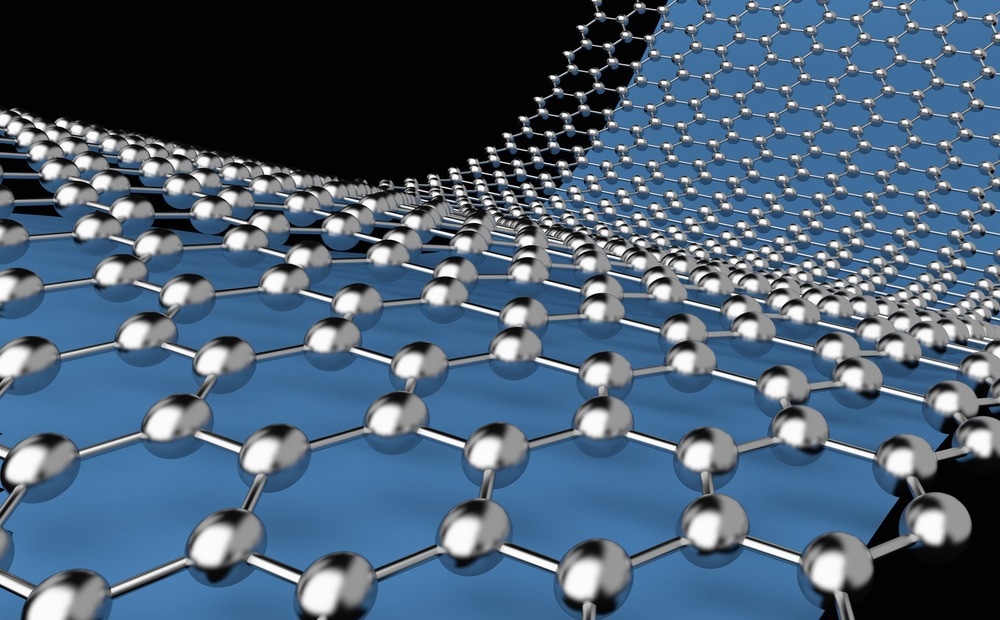The quantum-confined superfluid (QSF) concept has been proposed for ultrafast mass transport and is primarily related to the orderly flow of fluids in nanoconfined spaces. Although QSF channel-containing graphene oxide films have surfaced as smart materials for soft robots and actuators, QSF nanochannels have been modified to regulate the deformation of graphene oxide.

Study: Reconfigurable, Reversible, and Redefinable Deformation of GO Based on Quantum-Confined-Superfluidics Effect. Image Credit: Ambelrip/Shutterstock.com
An article published in Nano Letters presented an adjustable, redefinable, and reversible graphene oxide deformation method under moisture actuation by modifying QSF nanochannels via moisture-supported strain-induced wrinkling (MSW).
After the MSW process, the shape fixity ratio of the standard graphene oxide film was 84%, and the shape recovery ratio was 83% under moisture actuation at ambient temperature. Making robots out of graphene oxide was conceivable because of its deformation, flexible shaping capabilities, and self-healing characteristics.
In addition, as a proof-of-concept, soft robots and passive electronics that can crawl, spin, switch circuits, and automatically somersault has been demonstrated. Thus, future soft robots may benefit greatly from graphene oxide's unique shape and deformation capabilities.
Graphene Oxide-Based Smart Materials
The innovative uses of smart materials include soft robotics, biomedical devices, aeronautical engineering, and the ability to control deformation in response to external stimuli, such as heat, moisture, magnetic fields, and chemicals.
Hydrogels and azobenzene derivatives with swelling, twisting, and shrinking properties have been extensively studied as intrinsically smart materials. However, their robotic applicability is limited because of isotropic shape change or reconfiguration.
Smart materials could be mixed with other inert materials to create a stimulus-sensitive bilayer actuator that can provide better control over deformation. As a result, a stimuli-induced strain mismatch at the interface of the two materials results in predictable deformation and makes regulated actuation feasible.
Graphene oxide is a useful and promising material for graphene-based applications in electronics, optics, chemistry, energy storage, and biology. Recently, graphene oxide has surfaced as a flexible smart material for bilayer actuators like metals, polymers, metal oxides, biomaterials, and carbon.
Previous studies have described the fabrication of moisture-sensitive actuators based on graphene/graphene oxide bilayer fibers using selective femtosecond laser reduction. Subsequently, self-regulated photoreduction of a graphene oxide film was developed to create a photoreduction gradient in the typical direction for moisture actuation to build graphene oxide actuators with a larger area.
Furthermore, the direction of bending may be regulated by designing micropatterns. The self-controlled photoreduction of graphene oxide films can induce a photoreduction gradient along the direction of moisture actuation.
While a previous study validated the quick water transport in stacked graphene oxide, another study mentioned QSF, which refers to the ultrafast flow of water in the constrained two-dimensional (2D) nanochannel.
Deformation of Graphene Oxide Based on Quantum-Confined-Superfluidics Effect
In the present study, flexible tailoring of the QSF nanochannels of graphene oxide was demonstrated via the MSW effect, enabling reversible, reconfigurable, and redefinable distortions under moisture actuation.
The QSF-based graphene oxide actuators showed a quicker response to moisture than moisture-responsive graphene oxide with integrated inert materials. Moreover, QSF-based graphene oxide actuators could effectively prevent the instability of the interlayer adhesion.
Implementing the mechanical deformation of a graphene oxide film under high moisture conditions helped program the nanowrinkle’s orientation, resulting in the formation of QSF nanochannels due to the mismatch in strain and graphene oxide nanosheet’s reassembly.
Thus, actuating internally oriented QSF channels enabled the temporary shaping of the graphene oxide film into desired geometries. However, despite the shape, the graphene oxide film flattened under moisture actuation because of the rapid transport of water through the QSF channels, which led to a swelling effect.
Graphene oxide films could be employed in robotics due to their arbitrarily definable deformation ability. Here, the potential of the graphene oxide actuators in robotics was demonstrated by designing and fabricating three proof-of-concept soft robots, including crawling robots that could crawl approximately 1 centimeter within 15 seconds, a turning robot that could rotate 210 degrees in 56 seconds, and a somersault robot that can accomplish the somersault within 20 seconds.
Conclusion
In summary, the MSW effect of graphene oxide nanosheets resulted in the modulation of QSF nanochannels, facilitating flexible, redefinable, and reversible graphene oxide deformation under moisture actuation.
The deformation mechanism investigated experimentally and theoretically was attributed to the reversible deformation ability of the QSF nanochannels and water desorption/adsorption. A graphene oxide film could be defined as any temporary shape via a four-step process (hydration, fixing, dehydration, and releasing) and recovered to its original shape under moisture actuation.
Due to graphene oxide's flexible shaping and deformation abilities, moisture-responsive robots were fabricated using pure graphene oxide as a smart material. Furthermore, passive, electromechanical devices and soft robots have been developed as a proof-of-concept, indicating the potential of graphene oxide-based devices.
Reference
Ma, J. N., Zhang, Y. L., Han, D. D., & Sun, H. B. (2022). Reconfigurable, Reversible, and Redefinable Deformation of GO Based on Quantum-Confined-Superfluidics Effect. Nano Letters. Available at: https://pubs.acs.org/doi/10.1021/acs.nanolett.2c02212
Disclaimer: The views expressed here are those of the author expressed in their private capacity and do not necessarily represent the views of AZoM.com Limited T/A AZoNetwork the owner and operator of this website. This disclaimer forms part of the Terms and conditions of use of this website.